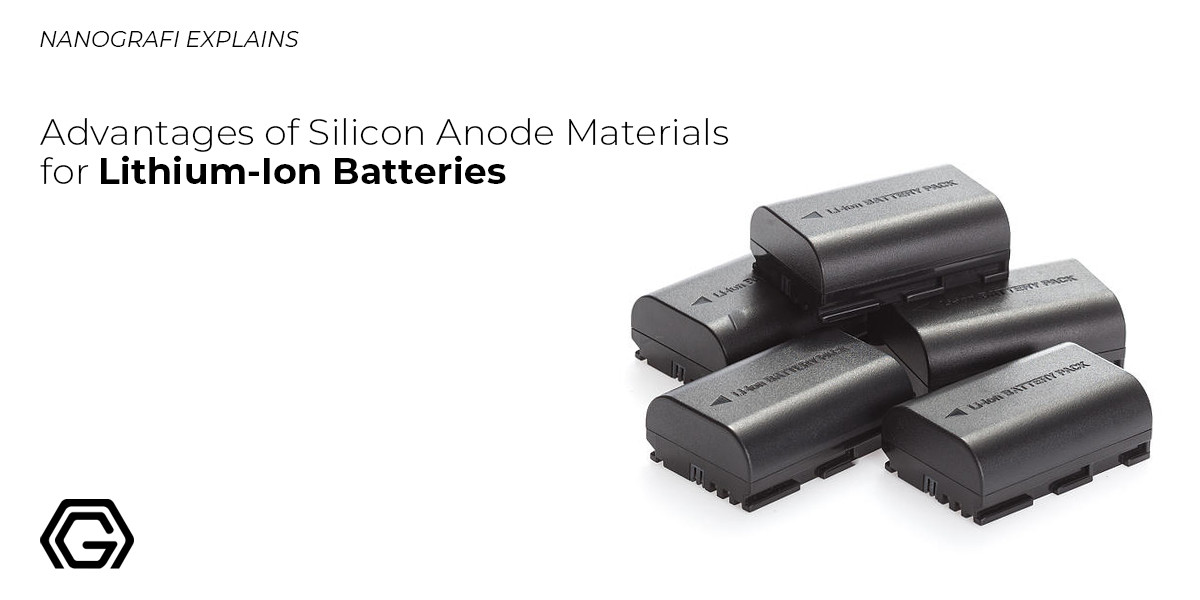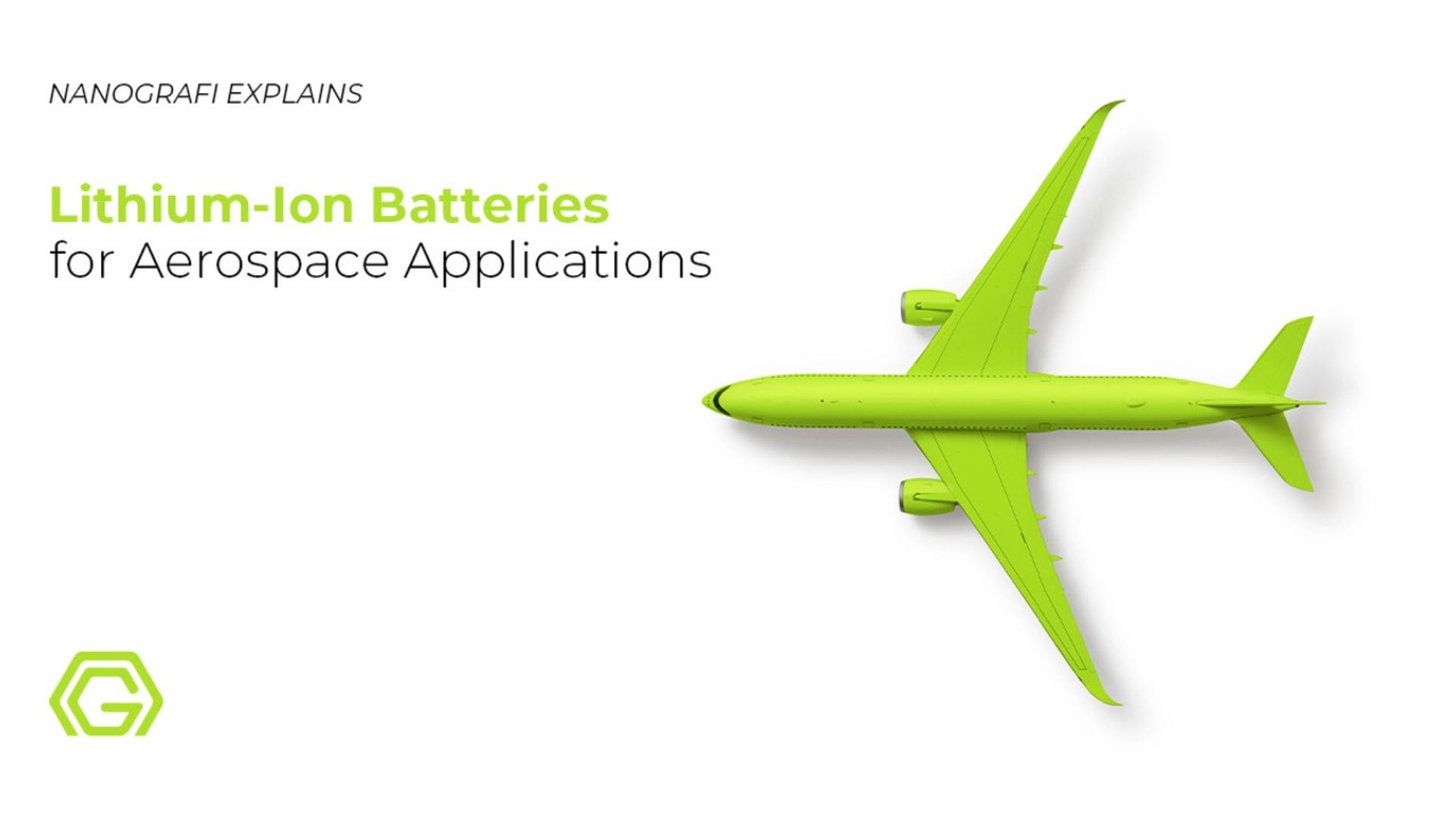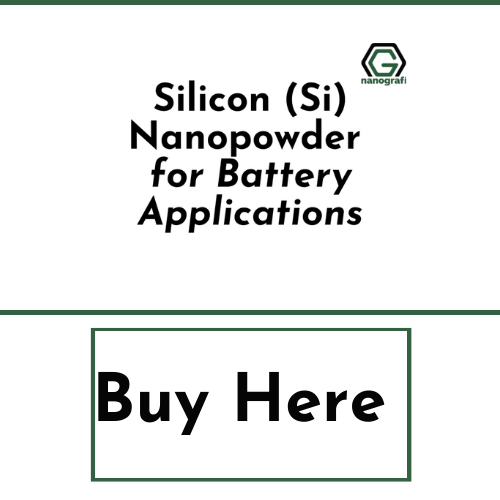Advantages of Silicon Anode Materials for Lithium-Ion Batteries
One of the broadly used systems of secondary batteries is Lithium-ion batteries (LIBs).
LIBs have limited self-discharging, operate at higher voltages, higher energy density, and requires less maintenance.With an increase in reliance on batteries, graphite-based electrodes are due for an upgrade.
Introduction
If we use Silicon instead of Graphite, it could result in safer and lighter batteries as Silicon has ten times higher capacity than Graphite, of 3,600 milliampere hours per gram (mAh/g). The most capable candidates are the materials that are based on Silicon because of the remarkable characteristics of Silicon, for instance, affordable, high energy density, and operating voltage.
Applications of Silicon Anodes
For applications in real life, the anodes should have high areal capacities and capacity for loading of high Si mass. Silicon Nanoparticles and Silicon encapsulation are the two best methods for lithium silicon batteries without any problems. Li–Si alloys operate at high temperatures. Lithium–silicon battery employs lithium ions as the carriers of charge and an anode based on Silicon. Consumer electronics will last 20 percent longer than normal because of Lithium-silicon batteries. Open any of your portable devices, like a phone, etc. and you'll see an electron providing a lithium-ion battery, plus a circuit board soaked in silicon routing those electrons to their desired location. In this review, lithium silicon batteries along with why Silicon is better than Graphite in a lithium battery, are explained in detail.
Lithium-Ion Batteries
In electronic devices of today, like laptops, smartphones, the best batteries are lithium-ion batteries. Lithium-ion batteries are unfortunately bulky and heavy. The flaky and soft material in pencil lead is Graphite, and it is a key component for a long time in lithium-ion batteries. On the microscopic level, carbon's multiple layers that are stacked on each another comprises Graphite. In LIB, traditionally, between these graphite layers, Lithium ions zip in and out of the vacant gallery spaces. Despite being an efficient anode, Graphite can't store much amount of Lithium. LIB's are broadly used for portable electronic devices as power supplies because of their volumetric energy and higher gravimetric densities as compared to other technologies of electrochemical energy storage, for instance, Ni-MH, lead-acid, and Ni-Cd batteries. All silicon lithium-ion batteries use Silicon as the anode, and for the cathode, lithium iron silicate is used. Silicon anode's performance can be improved through the formulation of electrode and optimization of the composition of the electrolyte. As electrolyte additive for silicon composite electrodes, fluoro-ethylene carbonate (FEC) was explored, and the coulombic efficiency and capacity retention were both highly enhanced by introducing 10 % FEC into the LP40 electrolyte. Conventional composite silicon electrodes require expensive and heavy copper collectors of current, meanwhile, a flexible electrode of Silicon consists of silicon nanopowder only. Electrode displays cycling in the long term, and good performance, both mechanically and in rate capability.
Alloying Materials
Various alloying materials, for instance, pure Sn, Si, Sb, Mg, Al, etc. have been broadly studied and are promising for the anode materials of next-generation in LIBs because of their high capacity as compared to Graphite. In comparison with other materials, materials that are silicon-based are the most capable candidates because of their remarkable energy density, less price, and moderate voltage for operating. In the 1970s, the kinetics and thermodynamics of the Li-Si alloying system were studied for the first time at increased temperature (400 °C), and many different crystalline phases were formed and reported.
Replacement of Graphite with Silicon
In comparison with Graphite, ten times higher capacity is contained by Silicon. The replacement of Graphite with Silicon will result in safer and lighter batteries. Despite Silicon storing more Lithium as compared to Graphite, Silicon expands in volume to about 300%, making the anode electrically insulating and break apart, which restricts the silicon-based lithium batteries to less than 100 lifecycles.
For researchers, Silicon in LIB as the anode displays the holy grail. In bucky papers, Carbon nanotubes are permeable to lithium ions, but traditional collectors of current such as copper are not permeable. This allows bucky papers to enable faster ion transport.
For lowering the costs of production of nanoparticles, raw material should be sourced from silicon wafer scrap. The chemical process is used to grind down the wafers into nanoparticles that are highly engineered and can be used for anodes of battery. When Silicon replaces Graphite in anodes of battery, a complex interplay of the variable is involved, not just for an increase in density of energy, but also for not reducing the thermal stability of the battery, its life span, or charge rate. For silicon lithium batteries first wave, small consumer electronics were used. Gadgets battery should last for some years. Batteries that are required by EVs should last more than a decade and should be able to accommodate to recharge daily temperatures of wide range and other unique stressors. The greater challenge is building a lithium-silicon battery that over a long time span, retains its high energy.
To get more information about lithium-ion batteries,
you can read our blog post here.
Silicon
An abundant element of earth, Silicon, is inexpensive to refine to high purity. The theoretical capacity of Silicon alloyed with Lithium is 3,600 milliampere hours per gram (mAh/g), as compared to graphite electrodes (372 mAh/g) energy density. Unlike carbon, Silicon has some inherent traits like the lattice structure expansion upon full lithiation (charging) by as much as 400%. For electrodes of bulk, great stress in the structure is caused within the expanding material, resulting in mechanical failure and fractures, therefore, limiting the silicon anode's lifetime. Group of researchers in 2011 gathered tables of data that summarized the method of preparation, composition, and morphology of those nanostructures and nanoscale silicon anodes, and also their electrochemical performance.
Bulk silicon materials are less reactive than Porous nanoparticles of Silicon, and porous one has silica's higher weight percentage due to the smaller size.
Due to small sizes of grain and novel structures, plenty of research was done for low-dimensional structures of Silicon, including wire and tube (1D), micro/nano-silicon particle (0D), and thin-film (2D). Silicon in size of small grains can highly accommodate the change of volume and offer adequate void space for expansion. Many functionalities could be provided by novel structures including enlargement of active material's surface area, shortening pathway of ionic diffusion, promoting electronic contact with conductive additives. Also, some methods of synthesis were mentioned, for instance doping with the functional element, additional conductive carbon coating, and formation of composite material, that is able to enhance the prepared anode material's electrochemical performance largely as well.
Silicon Nanoparticles
The promising potential is shown by commercially available silicon nanosized particles for being LIB's anode material of the next generation. Silicon's nano spherical structures relax the volume change generated stress during cycles, and own more surrounded free room.
Silicon nanoparticle using anodes may overcome the scale and price barriers of nanowire batteries, meanwhile providing more mechanical stability over cycling in comparison with other electrodes of Silicon. Carbon is typically added by these anodes as a conductive additive and for improved mechanical stability, a binder.
The Emergence of Si as LIB Anodes
In the 1970s, the experimental work started on the anodes that use chemical elements to make alloys with Lithium. It discovered in 1971 that at room temperature, it's possible for Lithium to alloys with many metals electrochemically. Formation at the high temperature of Li–Si alloys were reported in 1976, in between the range of 400-500 °C, cells were operating. Li22Si5 formation produces a 4200 mAh g-1 capacity, and it's highest than other alloy compounds of Lithium. In between 1990 and 2000, research was a bit limited on anodes that were Si-based, but these studies did trigger huge interest in the whole world, and they were inspiring enough for leading it to the point that in next decade, there will be a research on anodes that are Si-based for LIBs. Silicon is the most capable anode for lithium-ion batteries of next-generation just due to its proper voltage of working and exceptional capacity. There are many other reasons too for which Silicon is the best option, some of them are given below.
(1) Other than Lithium, Silicon has the highest volumetric capacity (9786 mAh cm-3), and the highest gravimetric capacity (4200 mAh g-1).
(2) On average, at 0.4 V, a suitable voltage is discharged by Silicon, that finds a stable balance in between avoiding the plating process of adverse Lithium, and retaining open circuit reasonable voltage.
(3) Silicon is less expensive, non-toxic, friendly to the environment, and second richest in the crust of the earth.
Lithium Silicon Battery
For a subclass of LIB technology, the used name is Lithium–silicon battery, and it has lithium ions as the carriers of charge and an anode based on Silicon. Silicon's specific capacity is 3600 mAh/g meanwhile Graphite has a specific capacity of 372 mAh/g. The main problem is a large change of the volume in Silicon when inserted Lithium (approximately 400% based on crystallographic densities), along with charged state's high reactivity for commercializing anode of this type. Anodes of the commercial battery may have Silicon in small amounts which is slightly boosting their performance. Amounts are kept secret for trade, limited from 2018 to at most 10% of the anode. In the 1970s, the first laboratory experiment took place on lithium-silicon materials.
A better battery was built by Sila Nanotechnologies with the secret ingredient being Silicon's nanoengineered particles that can supercharge cells of lithium-ion when used as the anode of a battery, or negative electrode. High energy EVs are the goal is long-term, but small devices will be the first stop. Lithium-silicon batteries make consumer electronics last 20% longer per charge. Lithium and Silicon are an excellent duo when it comes to most modern gadget's digital hearts. Open up any of your portable device, a laptop, smartwatch, or phone, you'll see an electron providing lithium-ion battery, and a circuit board soaked in Silicon which routes the electrons to their needed location.
Conclusion
LIBs have limited self-discharging, operate at higher voltages, higher energy density, and requires less maintenance. Silicon should be used instead of Graphite because Silicon has ten times higher capacity than Graphite, Silicon is affordable, has high energy density, and high operating voltage. Lithium–silicon battery employs lithium ions as the carriers of charge and an anode based on Silicon. Silicon makes the batteries last 20% longer. Not only 2D Si, 0D Si, 3D Si, 1D Si, but also the Si-based alloys, silicon nanostructures, Si-based multicomponent systems, and silicon encapsulation have also been studied broadly because of their reasonable tap densities and remarkable characteristics as LIB anodes.
To get more information, you can visit Blografi.
References
A new breakthrough in lithium-silicon batteries. (n.d.). Retrieved May 10, 2024, from https://www.nanowerk.com/spotlight/spotid=55716.php
Buckypaper and Its Potential Applications - Nanografi Nano Technology. (n.d.). Retrieved May 10, 2024, from https://nanografi.com/blog/buckypaper-and-its-potential-applications/
How to Use Mesocarbon Microbeads Graphite Micron Powders in the Battery Industry - Nanografi Nano Technology. (n.d.). Retrieved May 10, 2024, from https://nanografi.com/blog/how-to-use-mesocarbon-microbeads-graphite-micron-powders-in-the-battery-industry/
Lithium-Ion Batteries for Aerospace Applications - Nanografi Nano Technology. (n.d.). Retrieved May 10, 2024, from https://nanografi.com/blog/lithiumion-batteries-for-aerospace-applications/
Lithium–silicon battery - Wikipedia. (n.d.). Retrieved May 10, 2024, from https://en.wikipedia.org/wiki/Lithium%E2%80%93silicon_battery
Strategies for Improving Rechargeable Lithium-ion Batteries - Nanografi Nano Technology. (n.d.). Retrieved May 10, 2024, from https://nanografi.com/blog/strategies-for-improving-rechargeable-lithiumion-batteries/
Sun, Y., Liu, K., & Zhu, Y. (2017). Recent Progress in Synthesis and Application of Low-Dimensional Silicon Based Anode Material for Lithium Ion Battery. Journal of Nanomaterials, 2017. https://doi.org/10.1155/2017/4780905
Welcome to the Era of Supercharged Lithium-Silicon Batteries | WIRED. (n.d.). Retrieved May 10, 2024, from https://www.wired.com/story/welcome-to-the-era-of-supercharged-lithium-silicon-batteries/
Recent Posts
-
Advanced Materials for Unmanned Aerial Vehicle (UAV) Protection Against Laser
Consider a UAV on a critical mission, rendered inoperative by a sudden laser attack. With the increa …26th Jul 2024 -
Simulation and Modeling of Material Properties
Our world is composed of a dazzling array of materials, each with its own unique properties that dic …19th Jul 2024 -
Advanced Coatings for Superior Corrosion and Wear Resistance
Corrosion and wear pose significant challenges across various industries, leading to substantial eco …12th Jul 2024







